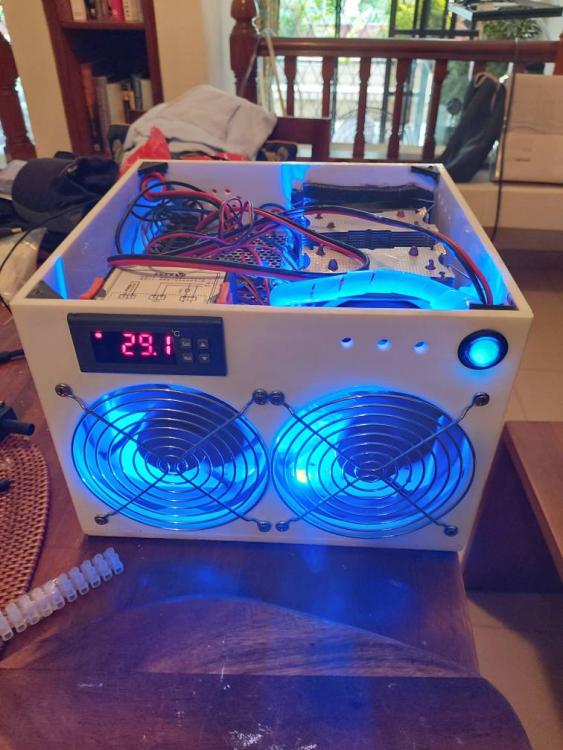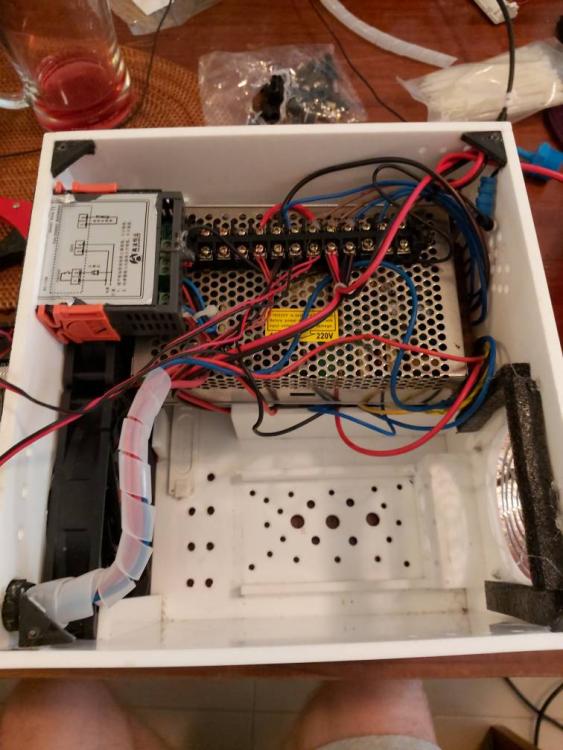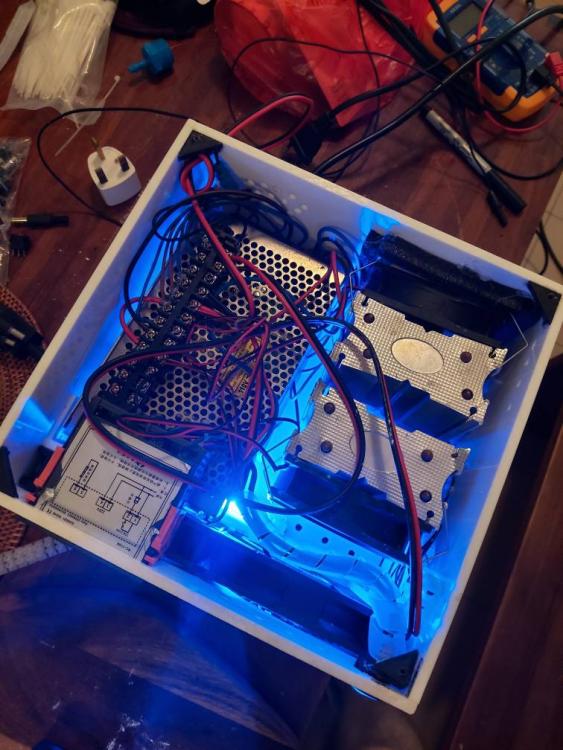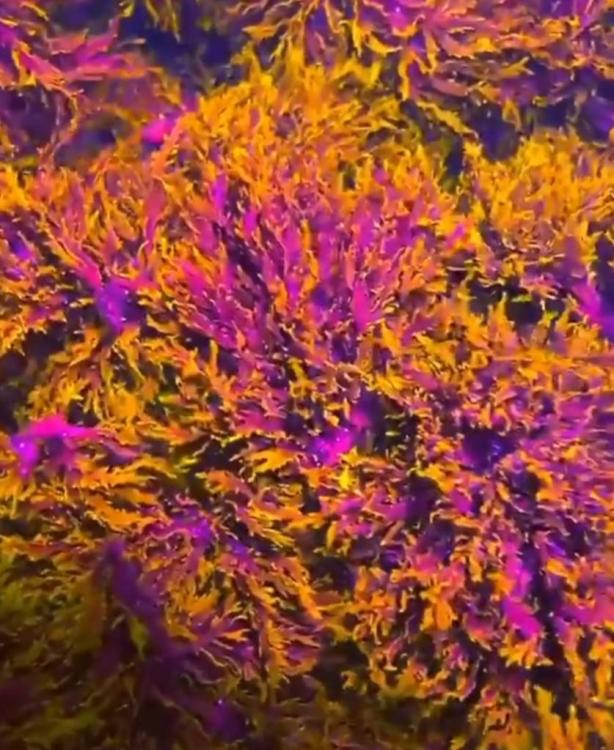-
Posts
313 -
Joined
-
Last visited
-
Days Won
25
Content Type
Profiles
Forums
Gallery
Everything posted by R0B
-
Build costs.... 12volt 20amp power supply $20 2x Peltier 12706 $7 Thermal paste $6 4x computer fans $15 Water block $12 Digital Temperature Controller $20 Acrylic Box $30 I also added some sockets in the back to power pumps when temperature is activated. Extra $10... So total was approx $120. (Which is the price of a secondhand chiller!) Sent from Singapore Reef Club mobile app
-
Thanks. Yes there are two. You could place two water blocks back to back and have a total of 4 peltier devices. You could then have the output of one water block go into the input of the other increasing the cooling effect. Personally I find the heat created offsets any true benefit. GHL are coming out with an electric chiller you may want to check that out. Personally I would just get a traditional chiller. It wont be on very long as it would chill the water quickly. Otherwise you would be running the electric chiller 24/7 which is what I have to do on my quaratine system. If after all this you are still thinking of making one, happy to guide you. They are fairly easy to be honest. Sent from Singapore Reef Club mobile app
-

anybody have live sand/ rock to spare?
R0B replied to shawnlim's topic in New to the Marine Aquaria Hobby
SAS have the brand, but whether they have in stock you would need to check. If you cannot find, another suggestion would be to pm@marineplanet he has some fritrtizyme 9 which could also work to turbo boost the cycle and his prices are very reasonable so wont break the bank. OR just wait it out (may take 30 days). With or without testing something is happening. When testing you should get an ammonia kit and a Nitrite test kit in addition to the more standard Nitrate kits. What you are watching for is a wave effect running through ammonia, nitrite and nitrate. Once you begin to see a decrease in your Ammonia (eventually to zero), followed by an increase in Nitrite followed by a reduction in Nitrite (eventually to zero) and corresponding increase in Nitrate, you know your tank is cycling. How big is your system? How big was the shrimp? Given the tank is at the right ammonia level If it is still visable get it out of the tank. It maybe that it is still releasing ammonia. You asked for rocks and sand? Does your tank have any of either of these (I think you said has sand, but does it have rocks?... just wondering if not what the bacteria is expected to live on?). Cycling is a waiting game... so Whilst you waiting and are on YouTube checking out Dr Tim, also check out BRSTV 5 Min series playlist. Is about 2hours total watching, but well worth the time. They have two episodes on cycling. Good luck. Sent from Singapore Reef Club mobile app -

anybody have live sand/ rock to spare?
R0B replied to shawnlim's topic in New to the Marine Aquaria Hobby
Slightly confused. You have been cycling for two weeks but added shrimp just three days ago? If so chillax and wait it out. You have ammonia in the tank so the ammonia oxygenating bacteria will start to do their thing. Classic cycles can take a long time. To help speed up the process lower the salinity slightly 1.020 and let the water get slightly warmer 82 this will give the bacteria a fighting chance. You mentioned you used live sand and Prodibio Start... you mean 'Start up'? This should be good if used correctly. The issue I see with these products is that they uses heterotrophic bacteria from the get go which I have read may actually inhibit the cycle. Suggest you watch Dr Tim Hovanec's MCNA presentation on cycling a tank on YouTube. Who knew that there were loads of different types of bacteria that need to be introduced at different times!? Aquarium systems have a bacteria starter kit, which introduces different bacteria at different set times which may be an option for you and is about $15. ...Else patience. Have you tested for Nitrite? Good luck. Sent from Singapore Reef Club mobile app -
I built a chiller unit for my quarantine system. (Attached are a few photos). Now my experience is that they can reduce the temp about 2 - 3 degrees on a small nano tank but struggle to go any lower. This maybe due to the quality of components, I used, or my DIY skills or even the design. They aren't that cheap to build but are fun fairly projects. Good luck. PM me if you need any help. Sent from Singapore Reef Club mobile app
-
According to their FB page... is Blk 114 Jurong East Street 13, #01-402 Sent from Singapore Reef Club mobile app
-
Anybody know where to source this macroalgae? Sent from Singapore Reef Club mobile app
-
It is recommended to have 3 to 5 times tank turnover through the sump. A 4x2x2 tank holds approx 420ltr (based on inside dimensions). So that means around 2000ltrs an hour . However, the issue is you need that at approx 4 to 5 foot of head pressure. Now add in a few elbows and you are most likely going to need a pump capable of delivering 2000ltrs at 1.8m of head pressure. With more items and distance covered this number clearly goes up. Various pumps perform significantly differently depending on their ability to handle head pressure. A Jebao 6000ltr return pump will give you 50% of its rated power at 1.8m (3000ltrs). Whilst an Ecotech Vectra despite being rated at just 5300ltrs is a lot more powerful and would be capable to pumping 3600ltrs at 1.8m. So the lesson learnt here is do check out the head pressure curves. Another consideration is heat. A pump running at lower power is likely to run cooler at any given pressure. So one way to keep the temp down is to set up a manifold. This will allow you to operate various items at differing flow rates. With some interesting plumbing you can even use it to circulate water in the sump, keeping it free of detritus. Good luck. Sent from Singapore Reef Club mobile app
-
I would agree with @Otaku. I personally run two return pumps. If one dies I can still get water to each part of the system. Best advice now is to go with slightly lower power pumps that share the load and not one massive over sized monster. Just make sure that a single pump can still keep the system running for a few days whilst you source a replacement or repair (I.e. has enough head pressure). If you for some reason cannot go with a two pumps suggest you invest in a quality return pump to reduce chance of an issue. Sent from Singapore Reef Club mobile app
-
Hi. Looking for something a little different in the form of Red Dragons Breath Macro Algae. If you know of any LFS or reefer that has some, please let me know. Thanks. Sent from Singapore Reef Club mobile app
-
Interesting. I wonder why that is? Is it a matter of the tank not having enough phytoplankton to keep them alive? or is it the type of copepod? I read that Calanoids do eat their young, so breeders separate them out. Which would mean limited in tank breeding. I wonder what reefers experiences / success are here?? Do you guys use the locally (Malaysia?) bred ones, or the commercial ones? Do you use as food soure or as part of an extended ecosystem? Sent from Singapore Reef Club mobile app
-
Thanks for the info folks. Most appreciated. Sent from Singapore Reef Club mobile app
-
Title kind of says it all. If anyone knows where I can source some live phytoplankton and/or Copepods (Apex, Tigriopus, Tisbe, or Apocyclops) please can you let me know. Thanks. Sent from Singapore Reef Club mobile app
-
Be proud. That is a awesome tank. Well done. Sent from Singapore Reef Club mobile app
-
What size system are you looking for; Pico, Nano, Small, medium, large? In tank or sump? Sent from Singapore Reef Club mobile app
-
Yep I second that! Really nice. Do you have any ID's for them? . Sent from Singapore Reef Club mobile app
-
First off, Dechlorinated water vs. RODI.... We are so lucky in Singapore to have some of the cleanest water available, but it still contains various elements that you wouldn't want in a reef tank! RODI systems firstly remove sediments, silt, clay... (it's amazing just how dirty my sediment filter gets from tap water!). The carbon filter and RO membrane remove any unwanted chemicals like chlorine, chromium, pesticides. Whilst the DI resin typically focuses on the removal of heavy metals like copper. Combined they remove impurities, microorganisms, disinfection byproducts, inorganic chemicals, organic chemicals, and even naturally occuring radioactive nuclides! Now whilst Declorinated tap water is okay to use short term all the above elements even in extremely small ppm/ppb will build up over time (Silicone even absorbs heavy metals). This will start to cause issues for you. Tap water vs. RODI... imho It's the difference between breathing in the haze and clean fresh air. Both will keep me alive, but I know which one I would prefer. Where to learn about corals??? YouTube is excellent. BRSTV is fantastic at putting together informative videos about gear and how best to implement a successful reef tank. For Corals specifically look for videos from "Tidal Gardens". Than Theim with his smooth voice will teach you everything you need to know about each different type of coral and much more.. Reefbuilders is another good website and YouTube channel. If you want I know "Reefbum" on youtube even has a subscription tutorial along with a book which is step by step guide to setting up and maintaining a successful reef tank. Reefdude, Reefnerd, reef dork, Reefman, Milehighreefers, Parker's reef, Aaron's aquarium, Fishofhex, americanreefchannel, and inappropriate reefer are all interesting channels to name but a few. Reef2reef is a great resource on every topic, from quarantine through to programming your Apex or GHL. Brands.... I have honestly wasted thousands buying cheaper gear, killing corals and fish, then slowly upgrading (please dont tell the wife). My advice to you is get the best from the beginning. If i was starting out again i wish i had gone with an established package (like a red sea ref tank.. plus all the trimmings) from your LFS. Or pick up a decom system here! If you want to build it up yourself BRSTV did a 'best of 2019' series, it's a good place to start to figure out what is what. Good luck. If you need any help just ask here there are many reefers here willing to help and guide where we can. Sent from Singapore Reef Club mobile app
-
I am no worm expert but you may want to check out "dorvilleidae" worm. Hopefully some worm experts here can help better ID. Sent from Singapore Reef Club mobile app
-
For any sump I would argue it is best to keep it clean (aka keep the alive stuff, remove the dead stuff). Clearly with an AIO it is a little more difficult as space is very limited. In that case I would say you have other higher priorities for the space you have. My humble suggestion would be that when you do a water change, every now and again Siphon out the compartments at the back. Hope that helps. Sent from Singapore Reef Club mobile app
-
Hmmm probably not. Bottled water tends to come from natural sources so there may be some interesting elements inside. If you want to go the bottle water route then use distilled water. On the original question of RO or RODI then this depends on what you aim to keep? what filters you are using? How often you plan on doing water changes? The RO may clear out most of the contaminants but often heavy metals are left over and this is where the DI comes into play. Even if you have heavy metal in the ppB range it can still have a big impact. Luckily Singapore tends to have good quality water. But your building may have older pipes. So you never know unless you do an ICP test for your property. Hope this helps Sent from Singapore Reef Club mobile app
-
Short answer... you would need 6-8 high powered computer fans running 24 hours to impact the water temp for a system of your size. However, a chiller is really your best bet. Long answer (with a bit of science and math)... the specific heat coefficient of salt water is 3,992 per litre per degree. Your tank and sump is approximately 580litres. So to decrease your tank temperature by 2 degrees you would need 3992x580x2 = 4,631kJ of energy. Now a good chiller would have a coefficient of performance (COP) of about 4, whilst a large 50w 18 inch fan with evaporation effect has approximately a COP of 1.33 (or so I can deduce from the interweb) depending on blade angle and RPM and surface area covered. So let's assume you have this 18 inch fan you would need 4,631kj/1.33 = 3,488kj to decrease the temp of your water by 2 degrees. Now assuming, you are NOT adding any heat back into the water (so all lights, pumps, skimmers and no wavemakers are switched on) and given that 1 watt is 1j/second, you would need to run your 18 inch fan for 3,488,000/50w =69,776 seconds or 19.38hours to decrease the water temp by 2degrees. However, you will need to run lights, pumps and skimmers and wavemakers. Assuming this doubles the cooling requirements (which is probably an under estimate given ambient temp and your 30+ degree tank) you are going to need to run approximately a total of 30inches of fan blade across your DT and Sump for 24 hours to keep the water 2 degrees cooler. So depending on fan size that can be 6 (140mm) or 8 (120mm) high velocity computer fans running 24/7 (plus a rather large ATO and a dehumidifier). The point is, fans are good for small systems to bring the temp down a little, they are cheap and effective. However for larger systems you need a chiller which is actually more cost effective in the long run. Hope that helps Sent from Singapore Reef Club mobile app
-

Help starting a nano cube marine tank
R0B replied to Jlkayden's topic in New to the Marine Aquaria Hobby
No need to use a 'starter' it will grow when you add a combination of light, water, chlorophyll, carbon dioxide and nutrients (basically an ATS and reef water). The algea will grow only as much as there are nutrients available, thus it grows in balance with the tank. Sent from Singapore Reef Club mobile app -

Help starting a nano cube marine tank
R0B replied to Jlkayden's topic in New to the Marine Aquaria Hobby
No it not. Whilst you can run an ATS during cycling as hair algea magically appears from nowhere refugiums are different. To sustain Chaeto you need nitrates and phosphates not nitrites and ammonia. If you add the chaeto you will stall your cycle. Which is not a good thing. As soon as the tank has cycled you can add a small amount of chaeto and go from there. Brightwell does a product called chaeto gro, although I have no personal experience of it, I heard it's good at promoting growth . One big tip. Please please consider where you get your chaeto from, because it is a really easy way to add pests into a brand new tank!! I recently got some and put it in QT You'll be amazed what crawls out after a few days. (Another reason why an ATS is actually slightly better than a refugium imho). Sent from Singapore Reef Club mobile app -

Help starting a nano cube marine tank
R0B replied to Jlkayden's topic in New to the Marine Aquaria Hobby
Suggest you first get a nice cup of tea and sit down and watch BRSTV 5min guide: ( ) Ok now you have spent 2 hours improving your understanding there are some basics you will need. 1. A Tank. Bigger is better. Suggest you check out the tanks here on the forum. There are some amazing deals here. Figure out if you want an all in one tank (internal overflow sump - ios) or run an external sump (basically another tank below) IMHO go with a sump. But that does open up the costs a little. IOS are also awesome but you have limited space. 2. Lighting. Corals need good light. Not just reasonably strong, but also the correct spectrum. Cheap lights that you use in fresh water simply won't cut it if you are serious. Check out AI prime as a basic entry into reef lighting it is an awesome light. Again loads of brands. 3. Flow. You will need some flow in your tank. So check out the jebao range for a fairly reliable but cheap range. A RW4 is the smaller wave maker ideal for a 2 ft tank or smaller (will cost you max 40bucks second hand). They go up in size RW8, 15, 20. Pick one that is appropriately sized. A good alternative is the SLW20, Nero 5, or Rosemont mover. There are loads of brands out there each doing the same thing.. they push water. 4. Mechanical filtration. If you go with an IOS tank then this will be filter floss and a mini skimmer. Skimmers are awesome as they create bubbles that lift the organics out of the tank. You need to do that before the orgsnics decay and produces loads of bad chemicals. For an external sump you will most likely have filter socks and a larger skimmer (dont oversize a skimmer.. just dont be tempted). 5. Chemical Filtration. Basically you will need a bag of Carbon and a phosphate remover. You can either throw these into a filter bag and place them into high moving areas of the sump. Reactors basically control the flow over these chemical removers. 6. Biological Filtration. You need to create the right environment to do that keep your nitrates low. One way is to have an ATS algea turf scrubber. Really difficult for a ios tank. But not impossible. Chinese black box ATS cost 40bucks. Refugiums also work excellently . Get some bio blocks to make sure your bacteria have a place to live. 7. Test kits. Get some test kits. You need to know where your tank is to drive it forward. Also get a refractometer to test salinity. 8. Salt water. Rodi 0tds water is key, simply add salt. But you can get NSW (natural sea water) from some local lfs. You will also need a way to add top off RODI water to the tank. The easiest way is an upside down bottle with two tubes hanging from it. But you can buy ato systems/pumps. 9. Temperature controller. Get something like an ink bird temperature controller. There are loads of other items, food supplements, doses, other toys. But go with 1-9 then add rocks, sand, simple corals and fish. Just an idea. Save some cash and see if any reefer is getting out the hobby. You can pick up a great bargain then. Good luck. Sent from Singapore Reef Club mobile app -
They will eats up the microscopic foods and organics left over. So it's a keeper! Sent from Singapore Reef Club mobile app






